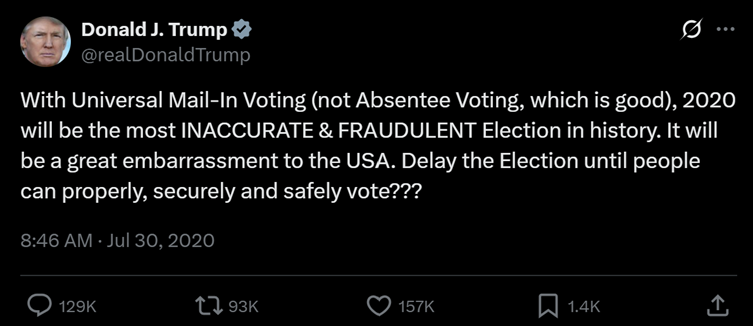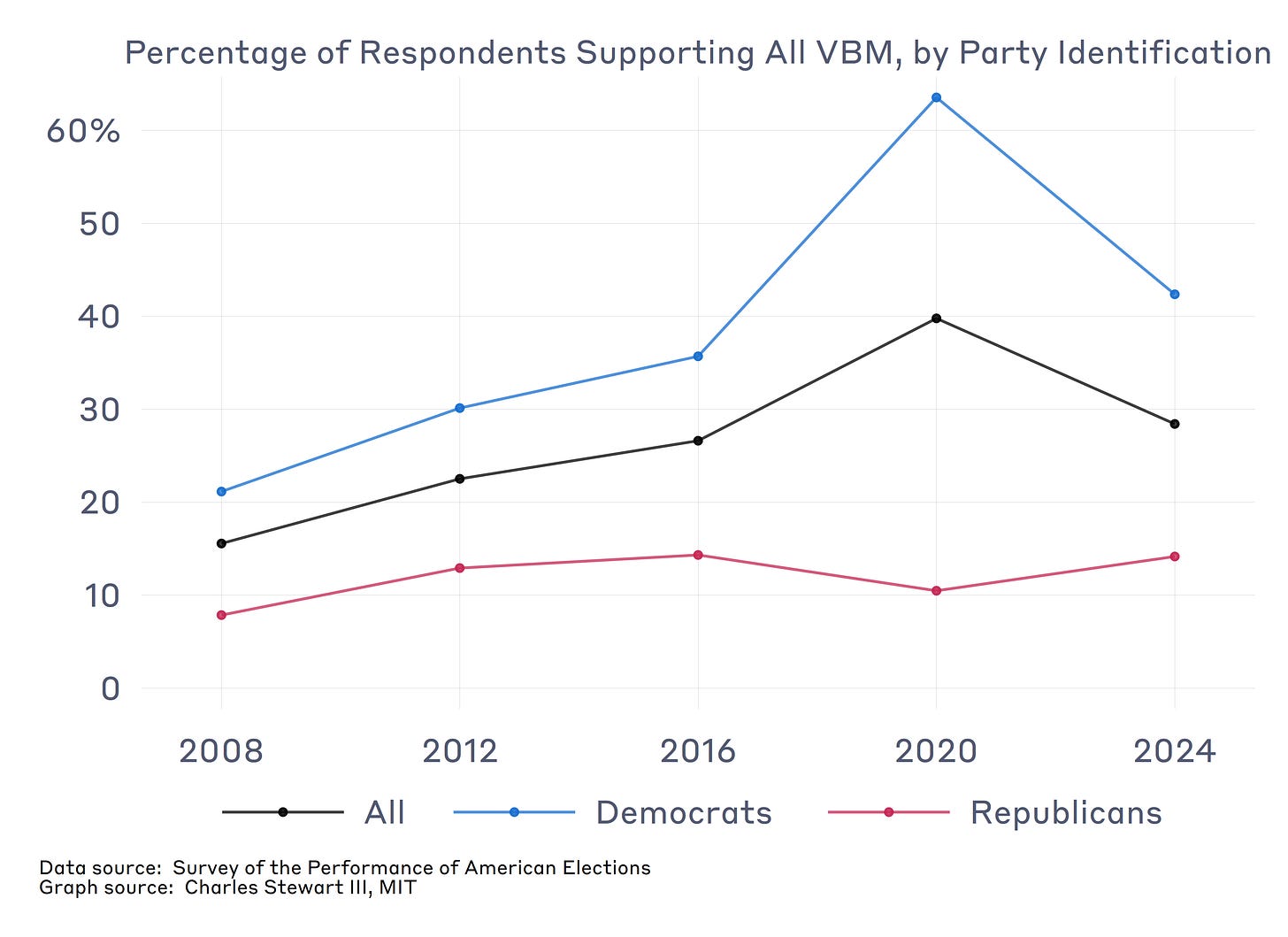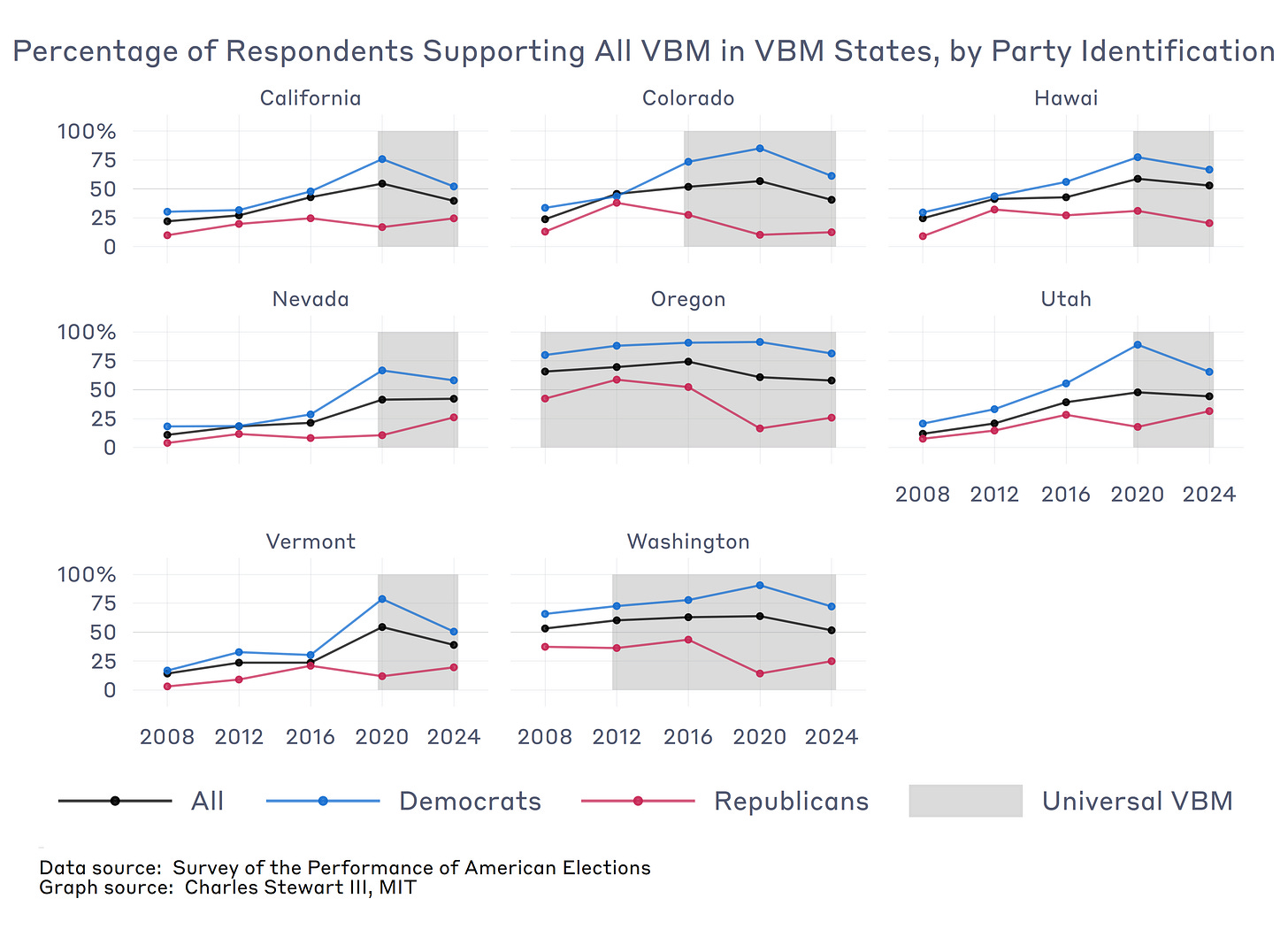Donald Trump's Movement
Donald Trump just declared he's leading a movement against vote-by-mail and voting machines. This political movement may be more enduring than his legal strategy.
President Donald Trump set off another flurry of activity on Monday with his social media post, attacking mail ballots and voting machines. Most attention to the post has been paid to his threatened executive order and claim that states are the agents of the Federal government in running elections.
Others have done well by handicapping the likely success of the threatened EO, criticizing his up-is-down reading of the Constitution, and fact-checking the claim that the U.S. is alone in allowing mail voting.
I want to focus on the least empirically challenged part of the post: that the president is “going to lead a movement to get rid of MAIL-IN BALLOTS, and also, while we’re at it, Highly “Inaccurate,” Very Expensive, and Seriously Controversial VOTING MACHINES. . .” (Emphasis added)
The only problem with this sentence is that he is already leading that movement—the push to delegitimize easily used mail-in ballots—and has been for a while. He is also claiming leadership of the anti-voting-machine movement, which will be the subject of another post.
Universal vote by mail is different from absentee ballots, sometimes in Donald Trump’s mind, and often in the minds of voters.
One of the things that confuses many people is that Donald Trump vehemently opposes voting by mail while still voting by mail himself. In the past, he has tried to make it clear that he distinguishes universal VBM and more traditional by-mail absentee voting. The clearest expression of this came in mid-2020, when he tweeted:
However, Trump has made this distinction less and less over time, to the point that his August 18, 2025 post seems to lump universal VBM in with traditional absentee mail ballots.
However, voters seem able to make this distinction. To see this, let’s start with their attitudes about universal VBM policies. Ever since it launched in 2008, the Survey of the Performance of American Elections has asked respondents whether they favored “run[ning] all elections by mail.”
Throughout this time, support for universal VBM has divided the two parties nationwide. Democrats’ support has grown steadily (with a 2020 spike), while Republicans’ support has held flat or declined, expanding the partisan gap from 13 points in 2008 to 53 points in 2020. The gap was cut nearly in half to 28 points in 2024, but is still twice that of the pre-pandemic period.
Donald Trump is not the only person to oppose universal VBM and still vote by mail. In 2024, 22% of Republicans and 28% of Democrats who opposed universal VBM nonetheless voted by mail in the election. If we exclude respondents from the eight universal VBM states in 2024, those numbers are 17% and 23%, respectively.
To be sure, these rates of mail-ballot usage are lower than among supporters of universal VBM. In the non-universal VBM states, mail ballots were used by 32% of Republicans who would support universal VBM and 41% of Democrats. So, opposition to universal VBM is correlated with a drop in the tendency to vote by mail, but it doesn’t drop it anywhere near to zero.
Clearly, voters—Republicans and Democrats alike—can distinguish between a policy that automatically mails every voter a ballot and requiring voters to ask for one. So, too, can party leaders. In the state legislative sessions held immediately after the 2020 election, as many Republican states were passing laws to tighten up voting procedures, no state that had had no-excuse absentee voting prior to 2020 eliminated it.
The future success of Trump’s anti-universal VBM movement faces political hurdles, not just legal ones.
If Trump wants his movement to succeed, he has about 90% of his supporters on his side on the issue of universal VBM, although a sizeable minority of his voters still rely on mail to vote. Not wanting to lose these discretionary by-mail voters, Republican state legislatures will likely be reluctant to roll back no-excuse absentee laws dramatically.
Of course, if the goal of the movement is really to roll back universal VBM, it has one important barrier: the state legislatures where VBM is currently the law.
It’s hard to believe that any federal court will agree with the proposition that
the States are merely an “agent” for the Federal Government in counting and tabulating the votes. They must do what the Federal Government, as represented by the President of the United States, tells them. . . .
Thus, to succeed in eliminating universal VBM, Trump will have to take his movement to the state legislative arena. Except for Utah, where universal VBM is scheduled for phase-out in 2029, universal VBM appears secure in the other states.
The most promising route to rolling back universal VBM in the remaining states would seem to be the citizen initiative. As it stands right now, support for universal VBM hovers around 50% in all states that have it. (See the figure below.) Five of the states where Democratic legislatures would block a universal VBM rollback (Oregon, Washington, Colorado, California, and Nevada) have the citizen initiative.1
In none of these states would an anti-VBM citizen initiative be a slam dunk. Yet, as the current initiative effort in California to require photo ID to vote suggests, it may be possible to harness public skepticism of some election administration practices to put conservative election policies in front of voters and then see what happens.
Trump’s movement may succeed as a political force when legal tactics fail.
I take President Trump at his word that he intends to use the full power of the federal government to try and force states with universal VBM to end the practice. As a legal and constitutional matter, I don’t think he’ll succeed. However, if it is a movement he wishes to lead, he may be more successful, though not universally so.
Trump’s opposition to universal VBM will undoubtedly spur conservative election activists in liberal states to ramp up efforts to gum up the works of mail ballots in these states. In this regard, they may learn from their efforts at pushing voting-machine skepticism.
At the same time, Trump will have to manage the enthusiasm of his supporters who would take his opposition to VBM as a signal that they should push hard to roll back no-excuse absentee voting in the many Republican states that have it. This raises the real possibility that, in the end, Republican voters and elected officials will end up bearing many of the costs of the movement’s efforts.
The initiative operates in different ways in these states, adding to the complexity of achieving the goal of rolling back universal VBM.





Love this post Charles! We got some interested data about this in a Maryland poll we did at CDCE earlier this year. https://cdce.substack.com/p/nearly-60-of-marylanders-support